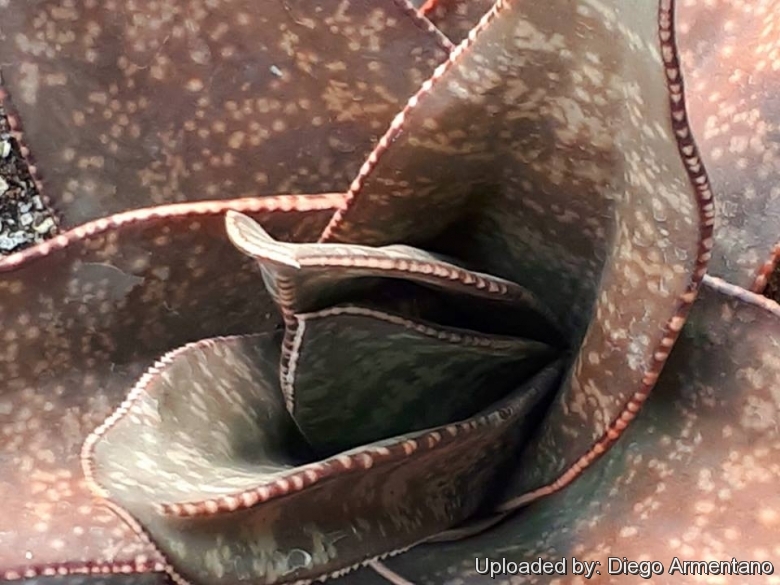




Your support is critical to our success.

Origin and Habitat: Gasteria excelsaSN|35333]]SN|35333]] occurs in the Eastern Cape, especially near the coast., South Africa.
Altitude range: 10-1400 metres above sea level. It has also been recorded at 1500 meters in the southern Drakensberg mountains, at a greater elevation than any other Gasteria species.
Habitat and ecology: This species is widely distributed in the thicket vegetation of the Transkei - both inland on high cliff-faces and near to the rocky coast. Its favoured habitat is dense shady thicket, rocky south-facing sheer cliffs and slopes. Precipitation, ranging between 600 and 1000 mm per year, occurs mainly during summer. The climate is subtropical, and frost in its habitat is a rarity. The leaves are brittle and new plants will proliferate from broken leaf fragments. The flowers appears in mid-summer (between November and February). Gasteria excelsaSN|35333]]SN|35333]] is pollinated by sunbirds. The vegetation in the habitat includes Acacia karroo, Euphorbia triangularisSN|27233]]SN|27233]], Cussonia spicata, Plumbago auriculata, Azima tetracantha, and Coddianthus rudis. Associated succulent species include Aloe feroxSN|710]]SN|710]], Ornithogalum longibracteatumSN|19756]]SN|19756]], Kalanchoe rotundifoliaSN|29139]]SN|29139]], Sansevieria hyacinthoides, Crassula perfoliataSN|11170]]SN|11170]], Sarcostemma viminaleSN|27584]]SN|27584]] and Haemanthus albiflosSN|18902]]SN|18902]]. The plants are common in their habitat, and not threatened. The sheer cliffs are difficult to negotiate and plants are thus well protected by their sheer habitat.
Synonyms:
- Gasteria excelsa Baker
ENGLISH: Thicket Gasteria, thicket ox-tongue
AFRIKAANS (Afrikaans): ruigte-beestong
Description: Gasteria excelsaSN|35333]]SN|35333]] is one of the largest of the Gasteria species, second only to Gasteria acinacifolia in height. Plants can grow quite large and consist of numerous thick, robust, angled, leaves that are arranged in strong solitary basal rosettes, 30-60 cm tall and 60-75 cm wide. These are dark green, and mottled with faint white flecks. The leaves of fully grown plants are often channeled on the upper side, with sharp edges, and (like its relatives) a keel on their lower side. Inflorescences can grow very large and consist of many horizontal branches. Flowers are pink at the base and green at the tip. The lower, belly-shaped portion of the flower is thin and narrow. Gasteria excelsaSN|35333]]SN|35333]] was introduced into cultivation about 1860 by T. Cooper. This is a variable species, with many forms and varieties. Like most Gasteria species, it also grades into related species, sometimes with a smooth range of intermediates.
Derivation of specific name: The specific epithet, excelsa, means "lofty" or "high" in Latin. It refers both to the great height of the plant's inflorescence, as well as to the high cliff-face habitat of this species.
Stem: Apparently acaulescent with a short leafy stem 5-7.5 cm long.
Leaves: Numerous (c. 10–30), thick, robust, arranged in a dense multifarious rosette, outer spreading, inner erecto-patent, triangular to elongated-triangular, (10-)20-30(-40) cm long, (6-)7,5-10(-18) cm broad and 12-18 mm thick, outer spreading to somewhat recurved, stiff, sharp, low down, face concave, back obliquely keeled, dull green, with a smooth surface (though juvenile plants' leaves are rough), with a few faint immersed spots of greenish-white arranged in transverse bands, which (rarely) may be barely visible, rarely striate. Margins, often very sharp, white-translucent, cartilaginous, interrupted with green, smooth, very obscurely papillose or heavily-serrated. Juvenile leaves distichous, densely white-spotted, patent, tongue-shaped and tuberculate.
Inflorescence: 1-3 per plant, erectly-branched 1-1.9 metres in heigh. Peduncle about 25-30 cm long. Branches erectly (rarely horizontally) spreading; racemes 8–10, forming a large deltoid panicle, each one 60 cm long, Pedicels 6-9 mm long; bracts lanceolate, as long as the pedicels.
Flowers: Pink-green Perianth 22-26 mm long, stipitate for 2-3 mm, tube oblong, gasteriform part narrowly ellipsoidm constricted to 5 mm in diameter, light pink (rarely white), 6-7 mm across at widest point. Segments tips white with green midstripes. Style included.
Fruits: 17-20 mm long, 8-12 mm broad.
Seeds: 4-5 mm long, 2-3 mm wide.
Chromosome number: 2n = 14.
Notes: In the north along the Mzimvubu river, a transitional form, between Gasteria excelsa and its northern neighbour Gasteria croucheriSN|17219]]SN|17219]], is now considered to be a separate transitional species, Gasteria loedolffiae.
Bibliography: Major references and further lectures
1) Wikipedia contributors. "Gasteria excelsa." Wikipedia, The Free Encyclopedia. Wikipedia, The Free Encyclopedia, 22 Mar. 2018. Web. 28 Aug. 2018.
2) EJ. van Jaarsveld: "Gasteria loedolffiae (Asphodelaceae). A new cliff-dwelling species from the Eastern Cape, South Africa". Kirstenbosch National Botanical Garden: Cape Town. 2014.
3) EJ. van Jaarsveld. "The genus Gasteria, a synoptic review". Aloe 44: 4: 84-103. 2007.
4) EJ. van Jaarsveld., Ellaphie Ward-Hilhorst, “Gasterias of South Africa: a new revision of a major succulent group”, Fernwood Press in association with the National Botanical Institute, 1994
5) Urs Eggli “Illustrated Handbook of Succulent Plants: Monocotyledons” Springer, 2001
6) J. G. Baker, "Flora Capensis", 1897
7) Gideon Smith, “Field Guide to Succulents of Southern Africa” Penguin Random House South Africa, 11 August 2017
8) Caryologia, Università degli Studi di Firenze, 1990
9) Foden, W. & Potter, L. 2005. Gasteria excelsa Baker. National Assessment: Red List of South African Plants version 2017.1. Accessed on 2018/08/28
10) Gasteria excelsa - PlantzAfrica information page. Web: http://pza.sanbi.org/gasteria-excelsa
11) Mucina, L. & Rutherford, M.C. (eds) 2006. "The vegetation of South Africa, Lesotho and Swaziland." Strelitzia 19. South African National Biodiversity Institute, Pretoria.
12) Gasteria loedolffiae - SANBI article. Web: http://pza.sanbi.org/gasteria-loedolffiae
13) Fl. Pl. South Africa 17: t.665 (1937).
14) Aloe 43[4]: 69 (2006).
Cultivation and Propagation: Gasteria excelsaSN|35333]]SN|35333]] thrives in cultivation, easily grown from leaf cuttings or seed. It is one of the largest of the Gasteria species. They are popular as ornamental plants for containers, but have a very large root system.
| Your Actions | |
|---|---|
| Back to Gasteria index | |
| Back to Aloaceae index | |
 |
Back to Succulents Encyclopedia index |
Privacy stantement - Terms and conditions - How to cite - About us - Feedback - Donate




